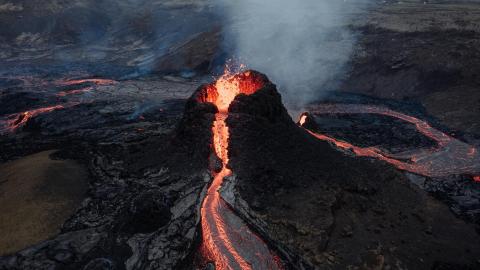What are dormant volcanoes good for? Copper mining

Credit: Ása Steinarsdóttir via Unsplash
This article was originally published on our sister site, Freethink.
Oxford scientists have proposed what they believe is a more sustainable approach to copper mining: digging deep wells under dormant volcanoes to suck out the metal-containing fluids trapped beneath them.
The status quo: Currently, most copper mining is done via open pits. Drills and explosives blast away rock near the surface, which is then transported to a processing facility. There, the rock is crushed so that the tiny portion of copper in it can be extracted.
This extraction process often involves toxic chemicals, and once the copper is removed, the waste rock that remains must be shipped to a disposal site so that it doesn’t contaminate the environment.
The challenge: All of the digging, extracting, and transporting involved in copper mining can be energy intensive and environmentally damaging — but the world needs more copper today than ever before.
Electric vehicles contain four times the copper of their fossil fuel-powered counterparts, and the metal is a key component of solar, wind, and hydro generators. That makes copper a key player in the transition to a more sustainable energy system.
The idea: Rather than focusing our copper mining efforts on rock, the Oxford team suggests we look to water — specifically, the hot, salty water trapped beneath dormant volcanoes.
“Volcanoes are an obvious and ubiquitous target.”
JON BLUNDY
These brines contain not only copper, but also gold, silver, lithium, and other metals used in electronics — and we might be able to extract them without wreaking havoc on the environment.
“Getting to net zero will place unprecedented demand on natural metal resources, demand that recycling alone cannot meet,” lead author Jon Blundy said in a press release.
“We need to be thinking of low-energy, sustainable ways to extract metals from the ground,” he continued. “Volcanoes are an obvious and ubiquitous target.”
Brine mines: After years of research, the Oxford team has published a study on the mining of metals from dormant volcanoes, and according to that paper, the process has tremendous potential — but it wouldn’t be easy.
The wells would need to be more than a mile deep, and there’s a small chance the extraction could trigger a volcanic event — something that would need to be assessed in advance of any drilling.
The equipment used for the extraction process would also need to be able to withstand corrosion from the brine and temperatures in excess of 800 degrees Fahrenheit.
Worth exploring: If these technical and safety challenges can be overcome, they predict that copper mining at dormant volcanoes would be more cost effective than at open pits.
It would also be less environmentally damaging, as geothermal energy from the volcanoes themselves could be harnessed to power the process.
And because dormant volcanoes are widespread, copper mining wouldn’t be limited to just a handful of countries, as is the case currently.
The next steps: The team is now looking for a site to dig an exploratory well, which should help them better understand both potential of tapping into this new source of metal and the challenges involved in the process.
“Green mining is a scientific and engineering challenge which we hope that scientists and governments alike will embrace in the drive to net zero,” Blundy said.





